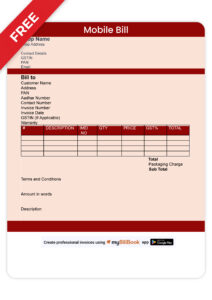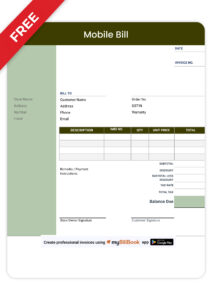Best Mobile Phone Bill Formats
in PDF, Word, Excel
India's #1 Billing Software
Free Mobile Invoice Formats - Download, Edit, and Share
Our free mobile bill formats help mobile shops to create invoices instanly!

Simple Mobile Bill Format
Easily generate bills for mobile phones, accessories, and repair services with a professional mobile bill format. This simple mobile invoice format includes essential details like product name, IMEI number, quantity, price, GST, and total amount. Perfect for small and medium mobile shops. Download in Word, Excel, or PDF and start invoicing instantly!
Advanced Mobile Bill Formats
Upgrade your billing with advanced mobile shop bill formats designed for seamless transactions. These mobile invoice formats are ideal for mobile retailers and service centres; these formats help you maintain organized records and enhance customer trust. Download in Word, Excel, or PDF and streamline your invoicing process today!


Stylish Mobile Bill Format
Make your invoices stand out with a stylish mobile bill format that reflects your brand’s identity. These bill formats come with modern layouts, custom branding options, and sleek designs, allowing you to add your logo, business details, signature, and watermark. Perfect for mobile retailers who want a polished and premium look for their invoices.
“Best free software to create invoices like quotations, sales and purchase invoices, delivery challans and more, on both mobile and laptop”
Features of Mobile Bill Formats on myBillBook
IMEI & Warranty Tracking
Custom fields to record IMEI numbers and warranty details for mobile phones ensure smooth tracking and hassle-free warranty claims.
Preloaded Mobile Product List
Save time with a built-in product catalogue, where you can quickly select mobile brands, models, and accessories instead of manually entering details.
Barcode Scanning
Scan barcodes, IMEI numbers, or serial numbers directly into the invoice for quick and error-free product entry, ensuring accurate billing and tracking.
Serialization & Batching
Keep track of stock effortlessly with the serialization and batching feature, allowing you to manage inventory by grouping products into batches and tracking their movement seamlessly.
Mobile Repair & Service Billing
Generate invoices for repair services, including spare parts, labour charges, and service tax, making billing seamless for mobile service providers.
Digital & Print Invoice Options
Instantly print mobile bill invoices or share them via WhatsApp, email, or SMS, ensuring a smooth customer experience and reducing paper usage.
Try India’s easiest billing and invoicing platform
“Generating mobile bills is effortless with myBillBook’s ready-to-use templates.”

Vardhan, Durga Mobile Centre
“Pre-designed mobile bill formats make invoicing quick, easy, and professional.”

Lokesh Kumar, Smart Globes
“Mobile billing is seamless with automated tax calculations and custom templates.”

Rajesh Kumar, Nav Durga World
Pricing plans
Diamond Plan
₹217
Per month. Billed annually. Excl. GST @18%
✅ Create unlimited invoices
✅ Add up to 1 business + 1 user
✅ Inventory management
✅ App + Web support
✅ Priority customer support
✅ GSTR reports in JSON format Popular
Platinum Plan
₹250
Per month. Billed annually. Excl. GST @18%
Everything on Diamond Plan +
✅ Add up to 2 business + 2 user
✅ 50 e-Way bills/year
✅ Staff attendance + payroll
✅ Godown management
✅ Whatsapp and SMS marketing Popular
Enterprise Plan
₹417
Per month. Billed annually. Excl. GST @18%
Everything on Platinum Plan +
✅ Custom invoice themes
✅ Create your online store
✅ Generate and print barcode
✅ POS billing on desktop app
✅ Unlimited e-Invoices & e-Way bills
Choosing the Right Mobile Bill Formats
What is Mobile Bill Format
A mobile shop bill book format allows mobile shop owners to generate bills easily. Instead of using a random mobile shop bill format, having a customised invoice template for your mobile shop makes invoice generation more specific.
Compared to traditional hand-written bills, invoices generated with billing software look more professional. Even though you own a small mobile business, providing invoices in a customised format builds trust among your customers.
Also, electronically recorded invoices help mobile shops manage and track their mobile sales easily. Not just sales tracking, using billing software to produce invoices helps with better stock management, tax filing, report generation, and so on
Mobile Shop Bill Format – Mandatory Fields
The GST law mandates the display of certain elements related to the sale on every mobile shop GST invoice. Below is the list of contents you need to display on your mobile store’s invoice.
- Your mobile shop’s name, address and GSTIN, if GST registered
- A unique serial number
- Billing Date
- HSN Code, if applicable
- Details of the products sold
- Quantity
- The total worth of the products
- The taxable value of the products
- Rate and amount of GST (CGST, SGST, IGST, UTST or cess)
- Total bill amount
- Signature/digital signature of the supplier
- Terms and conditions
- Bank account details or UPI details
While creating a mobile shop invoice, ensure you include all the above-mentioned items.
Mobile Shop Bill Format in Word, Excel, PDF and Google Docs
Now that you know the mandatory fields to include in the mobile shop bill format let us tell you how to create a mobile shop bill format in different ways. Some of the most commonly used invoice formats include mobile shop bill format in PDF, mobile store bill format in Excel, cell phone shop invoice format in Word and mobile store bill format in Google Docs. Let’s check each one of them in detail.
Mobile Shop Bill Format in Word
Bill Book format for mobile shops can be designed in MS Word with different customisation options. If you have MS Word installed on your device, simply open a new document, create the invoice (by taking reference) as per your business requirements, save it and use it as a template whenever you want to generate an invoice. If you’re finding it difficult to create one, use the free Word invoice template for mobile shops provided below.
Mobile Shop Bill Format in Excel
To further simplify the invoice creation process for your mobile shop, you can use MS Excel to create invoice format. MS Excel has a set of rows and columns that help you create an invoice much easier. Take an invoice format as a reference and try to replicate it in the Excel sheet. If you’re finding it difficult to create one, use the free Excel invoice template for mobile shops provided below.
Mobile Shop Bill Format in PDF
Creating invoices for your mobile shop in PDF is more secure. When you share a PDF invoice online, the receiver may not be able to edit or change it, while they could do the same in Word and Excel. You can convert a Word or Excel invoice format for mobile shops into a PDF by simply downloading it as a PDF. Use the free PDF invoice below to create a mobile shop bill in PDF.
Using Billing Software to Generate Mobile Shop Bill Format
If you find creating a mobile shop bill format difficult using Word, Excel or any other online tools, you can try using a billing and accounting software like myBillBook.
myBillBook is a billing software for mobile shops designed to simplify the billing and accounting needs of small and medium businesses like your mobile shop in India.
- Besides providing pre-designed invoice templates, the billing app also allows you to create custom invoices of your choice.
- You can generate invoices in seconds using myBillBook
- The software automatically calculates the transaction’s tax amount and total value and applies discounts and promotions, if any, thus avoiding time-consuming manual calculations.
For retail businesses, especially mobile shops, billing software for retail shops can streamline the entire billing process, offering features such as inventory tracking, automated tax calculations, and detailed reporting, ensuring smooth financial operations.
- It also helps you keep track of all your sales and makes tax filing easy and efficient.
FAQs on Mobile Bill Format
What is mobile bill format PDF?
Mobile bill format PDF is a bill format available in PDF. A PDF document is uneditable hence can be shared to customers securely.
Can a mobile bill format be customised?
If you’re using a free online template, there is no option to edit it. You simply need to download it, fill it out manually and share it with your customers. If you’re using an online invoice generator, you can fill out the fields as required but cannot modify or add new fields. You can then download and share.
Only when you’re using billing software like myBillBook can you customise the invoices according to your requirements. You can add or remove fields, change colours, add brand logos, watermarks, signatures, and other customisations as available.
Can I add custom fields to my mobile shop invoice?
Using billing software like myBillBook billing software, you can add custom fields and delete irrelevant fields for your mobile business.
Is myBillBook billing software for mobile shops expensive?
The main mission of myBillBook is to enable SMBs and MSMEs to digitise their businesses. Hence, the software is offered at an affordable price, and based on the features and customisations it allows, the plan might vary. Check myBillBook pricing plans.
Can I use mobile shop bill software on my mobile phone?
Yes, you can use mobile shop bill software on your mobile, provided the billing software offers a mobile application. myBillBook offers both web and mobile apps enabling mobile shop owners to generate invoices from anywhere.
Know more about Billing & Accounting Software for Small Businesses
Retail Inventory Management Software
Real Estate Billing and Accounting Software
Department Store Billing Software
Ecommerce Inventory Management Software
Travel Agency Accounting Software
Restaurant Inventory Management Software
Construction Accounting Software


